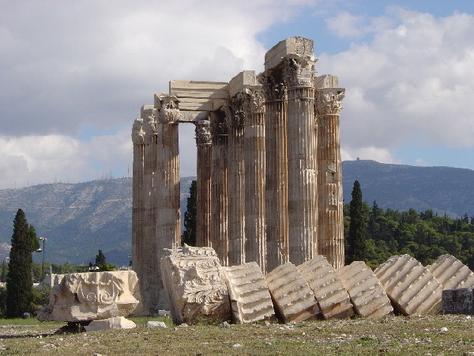Tyler Coffin and Patrick Wroe

The Temple of the Olympian Zeus
In the mind of Aristotle, tyrants used people as mindless workers, thus creating a work of art on an enormous scale. The Olympeion, or the Temple of the Olympian Zeus, is one such work. Many think that the Temple of Olympian Zeus was created during the Hellenistic period, but it actually only began in the Hellenistic period. It took centuries to finish, and not until the middle years of the Roman Empire was it finally completed.
History
Construction on the Temple of the Olympian Zeus, or the Olympeion (Connolly and Dodge, 78), as it has also been called, began during the Hellenistic Period in Greece, and was begun by the tyrant Peisistratus, in his efforts to better the city of Athens. He began it in the year 550 B.C.E. His other efforts included building an aqueduct and making the market system in Athens more civilized and easier to work. After he died, the temple was partly destroyed and his two sons began to rebuild it. The sons were overthrown in 510 B.C.E. and work on the temple stopped completely, perhaps becuase of the association with the tyrranical ruler. (Connolly and Dodge, 78)
[Picture: Athens, Temple of Olympian Zeus, begun late 6th century BC, completed first half of 2nd century AD; photo credit: SEF/Art Resource, NY]
The Ups and Downs of the Olympeion
 When Athens was sacked in 479 B.C.E. by the Persians, the temple's construction was set back. The Persian warriors could have contented themselves with knocking down the temple that had not yet been finished. Even if that did have an effect on the temple, some of the column drums were broken up and used by the Athenians to build a city wall around the area. (Connolly and Dodge, 78)
When Athens was sacked in 479 B.C.E. by the Persians, the temple's construction was set back. The Persian warriors could have contented themselves with knocking down the temple that had not yet been finished. Even if that did have an effect on the temple, some of the column drums were broken up and used by the Athenians to build a city wall around the area. (Connolly and Dodge, 78)
After the city was sacked, there were almost always more important projects to complete, more important things to be done. Rebuilding the Temple of the Olympian Zeus was very low on the list of priorites, and was not given any thought for the next few centuries. (Connolly and Dodge, 78)

The Reconstruction of the Temple
300 years after that, the Hellenistic King Antiochus Epiphanes IV of Syria re-began construction on the temple in 174 B.C.E. His attempts were in vain, as he could not
completely reconstruct the temple before his death in 164 B.C.E.
His attempt was designed by the Roman architect Cossutius, although there is no particularly Roman influence in his work on this temple.
The temple lies at the bottom of the Acropolis, in Athens, Greece.
The temple is much bigger than normal Greek Architecture, mostly due to the fact that it was not wholly Greek. It was completed in the year 132 C.E. under the Roman emperor Hadrian.
[Picture: Temple of Olympian Zeus (Olympieion), ruins, photo credit: photos.igougo.com]
The Decline of a Giant
After it had waited 700 years or so to be finished, it was damaged beyond repair in the year 287 C.E. during the Herulian attack on Athens. After it had been nearly destroyed, the religious practices that surrounded it were banned by Emperor Theodosius II in the year 425 C.E.
Architecture
The columns that have remained intact over the years are huge, standing around 57 feet taller than the base of the temple. Even though it was designed by a Roman citizen, it still retains solidly Greek architectural conventions, namely, the three-stepped base, the series of rooms, all surrounded by columns, and all of the conventional proportions. The temple and its columns are of the Corinthian order, with 8 x 20 columns in each row and a third row on either end.
[Picture: Akragas, Temple of Olympian Zeus (Olympieion), plan and elevation, c. 480 BC]
Biblography
Connolly, Peter, and Hazel Dodge. The Ancient City: Life in Classical Athens and Rome. Oxford, Great Britain: Oxford University Press, 2000.
Lawrence, A. W. Greek Architecture. New Haven, Connecticut and London, England: Yale University Press, 1996.
Stokstad, Marilyn. Art: A Brief History. Upper Saddle River, New Jersey: Pearson Prentice Hall, 2007.
Wikipedia. “Temple of the Olympian Zeus (Athens).” Wikipedia. 8 Dec. 2008 <http://http://en.wikipedia.org/wiki/Temple_of_Olympian_Zeus_(Athens)>.
Comments (3)
Patrick Wroe said
at 3:01 pm on Dec 1, 2008
Tyler and Patrick are da bomb
Patrick Wroe said
at 2:30 pm on Dec 8, 2008
hey Tyer
wasss UPPPPPP.!!!!!
Arri said
at 2:13 pm on Dec 17, 2008
OOOOOoooooooo PRETTY COLORS!!! NAAaaaa...
You don't have permission to comment on this page.